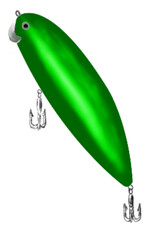wobbler

A wobbler (or "plug") is a fishing lure designed to resemble a fish of prey, or some other natural food of predatory fish. As the name signifies, it makes wobbling movements that are caused by the mouth dish or "bill" on the plug which causes it to wobble and dart as it moves through the water. Plugs have a body made of plastic or wood and are designed to be used on top of the water or at depths below the surface. Topwater or floating plugs are designed to float on the surface. Diving plugs have plastic or metal lips so they will dive to a certain depth. These diving plugs are often called "crankbaits" because they are often used with baitcasting reels that operate like a crank.
The typical build of a wobbler consists of:
- a body made out of light wood or plastic, sometimes separated into two pieces joined by a small flexible link to enhance the impression of a fish whipping its tail fin.
- a mouth dish, or bill, sometimes adjustable to change depth and wobbling movements of the lure.
- Hooks, often in groups of three hanging freely on a maximum of three points (front, middle and rear end) as this is the maximum number of hooks allowed on a single lure.
- A ring for attaching the fishing line.
Design Parameters
Wobblers can be designed to float on the surface of the water and stay afloat when they are retrieved, or to float but dive under the surface upon retrieval. They can also be designed to sink slowly or rapidly, or to dive deeply on retrieve, by use of a steeply angled or longer-than-normal mouthpiece. Some have a small metal ball inside to "rattle" when retrieved. They can be finished in a wide variety of colors and color patterns, or printed with very lifelike "fish" patterns. Some wobblers have no built-in action at all, being designed to let the fisherman create the action in the plug by his own manipulations of the rod and line.
<< Home